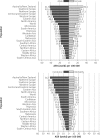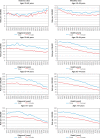Epidemiology of colorectal cancer: incidence, mortality, survival, and risk factors
- PMID: 31616522
- PMCID: PMC6791134
- DOI: 10.5114/pg.2018.81072
Epidemiology of colorectal cancer: incidence, mortality, survival, and risk factors
Abstract
According to GLOBOCAN 2018 data, colorectal cancer (CRC) is the third most deadly and fourth most commonly diagnosed cancer in the world. Nearly 2 million new cases and about 1 million deaths are expected in 2018. CRC incidence has been steadily rising worldwide, especially in developing countries that are adopting the "western" way of life. Obesity, sedentary lifestyle, red meat consumption, alcohol, and tobacco are considered the driving factors behind the growth of CRC. However, recent advances in early detection screenings and treatment options have reduced CRC mortality in developed nations, even in the face of growing incidence. Genetic testing and better family history documentation can enable those with a hereditary predisposition for the neoplasm to take preventive measures. Meanwhile, the general population can reduce their risk by lowering their red meat, alcohol, and tobacco consumption and raising their consumption of fibre, wholesome foods, and certain vitamins and minerals.
Keywords: colorectal cancer; epidemiology; incidence; risk factors.
Copyright: © 2019 Termedia Sp. z o. o.
Conflict of interest statement
The authors declare no conflict of interest.
Figures









References
-
- Vogelstein B, Fearon ER, Hamilton SR, et al. Genetic alterations during colorectal-tumor development. N Engl J Med. 1988;319:525–32. - PubMed
-
- Peifer M. Developmental biology: colon construction. Nature. 2002;420:274–5. - PubMed
-
- Medema JP, Vermeulen L. Microenvironmental regulation of stem cells in intestinal homeostasis and cancer. Nature. 2011;474:318–26. - PubMed
Publication types
LinkOut - more resources
Full Text Sources
Other Literature Sources
Medical
